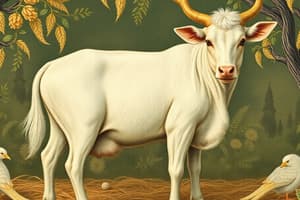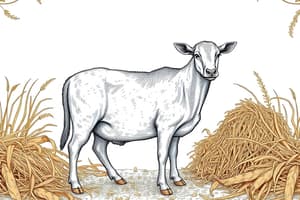Podcast
Questions and Answers
What is roughage?
What is roughage?
Plant material of one kind or another that provides dietary carbohydrates for herbivorous animals.
In the US, roughages comprise over ____% of all feedstuffs fed to livestock animals.
In the US, roughages comprise over ____% of all feedstuffs fed to livestock animals.
50
What does forage refer to?
What does forage refer to?
Total plant material available to be consumed by an animal.
How do you describe roughage in the context of dietary components?
How do you describe roughage in the context of dietary components?
To most livestock feeders, roughage is a bulky feed that has a low _____________ per ______ of volume.
To most livestock feeders, roughage is a bulky feed that has a low _____________ per ______ of volume.
Roughage feedstuffs have high crude fiber (CF) content & lower digestibility of components such as ____________ and ____________.
Roughage feedstuffs have high crude fiber (CF) content & lower digestibility of components such as ____________ and ____________.
Roughages are classified as a feed that contains greater than ____% ___________ ___________ and less than ____% _______
Roughages are classified as a feed that contains greater than ____% ___________ ___________ and less than ____% _______
Nutrients in roughages are made available by microbial digestion in the ____________ and ____________.
Nutrients in roughages are made available by microbial digestion in the ____________ and ____________.
What are the types of roughages for feed?
What are the types of roughages for feed?
Forages are plants that are grown specifically for feeding ___________.
Forages are plants that are grown specifically for feeding ___________.
Forages are mostly ____________ or ______________ although in native range, many browse (tree leaves) species are utilized.
Forages are mostly ____________ or ______________ although in native range, many browse (tree leaves) species are utilized.
The major component of forages is _______________. There are 100 billion tons of it synthesized by plants every year. It is composed entirely of ______________.
The major component of forages is _______________. There are 100 billion tons of it synthesized by plants every year. It is composed entirely of ______________.
Roughages contain high amounts of plant _______ ________, which varies considerably among sources.
Roughages contain high amounts of plant _______ ________, which varies considerably among sources.
_______ fraction estimates the cell wall content of a feedstuff.
_______ fraction estimates the cell wall content of a feedstuff.
What are the high contents of cell wall material (NDF)?
What are the high contents of cell wall material (NDF)?
What is the purpose of the interior vacuole in plant cells?
What is the purpose of the interior vacuole in plant cells?
What are the cell contents of forages that are metabolically active?
What are the cell contents of forages that are metabolically active?
__________ comprises the cell wall and is the structural system for the plant.
__________ comprises the cell wall and is the structural system for the plant.
The _____________ and _____________ are found within the plant cell; they are cell contents and are not part of the structural system of the plant.
The _____________ and _____________ are found within the plant cell; they are cell contents and are not part of the structural system of the plant.
________________ and ____________ provide structural strength to the cell wall.
________________ and ____________ provide structural strength to the cell wall.
What are cellulose molecules arranged in?
What are cellulose molecules arranged in?
What two components make up the cell wall matrix?
What two components make up the cell wall matrix?
The cell wall matrix contains a considerable amount of ___________, which forms a viscous gel.
The cell wall matrix contains a considerable amount of ___________, which forms a viscous gel.
As cell growth decreases, water is replaced with ___________ and the matrix becomes permeated. This process is called __________________.
As cell growth decreases, water is replaced with ___________ and the matrix becomes permeated. This process is called __________________.
What is the space between cells called?
What is the space between cells called?
What two things does the nutritional value of forages depend on?
What two things does the nutritional value of forages depend on?
As a grass or legume matures, lignin content (increases/decreases), reducing __________________.
As a grass or legume matures, lignin content (increases/decreases), reducing __________________.
Flashcards are hidden until you start studying
Study Notes
Roughages Overview
- Roughage is plant material that provides essential dietary carbohydrates for herbivorous animals, crucial for domestic ruminants and horses.
- In the US, roughages account for over 50% of all feedstuffs for livestock.
- Forage refers to the total plant material that animals consume.
Characteristics of Roughage
- Roughage consists of dietary components high in structural fiber.
- It is characterized as a bulky feed with low weight per unit volume; for example, corn grain occupies less space than alfalfa hay.
- Roughages typically have high crude fiber content and lower digestibility of protein and energy.
Classification of Roughages
- Roughages are classified as containing greater than 18% crude fiber and less than 70% Total Digestible Nutrients (TDN).
- Nutrients in roughages are made available through microbial digestion in the rumen and hindgut.
Types of Roughages
- Types of roughages for feed include:
- Pasture
- Hay and dehydrated forage
- Silage
- Crop residues
- By-products (e.g., straw, hulls)
Forages and Their Composition
- Forages are specifically grown for feeding animals and are primarily grasses or legumes.
- In native ranges, various browse species, such as tree leaves, are also utilized.
- Cellulose is the major component of forages, synthesized at around 100 billion tons annually by plants.
- Roughages contain high amounts of plant cell walls, with significant variation between sources.
Nutritional Content and Structure
- Neutral Detergent Fiber (NDF) estimates the cell wall content of feedstuffs.
- The high content of cell wall material includes components like cellulose, hemicellulose, pectin, silica, and lignin.
- The cell wall structure serves as a system for plant rigidity, while starches and sugars are found within the cell.
Cell Wall Composition
- Cellulose and lignin contribute to the structural strength of the cell wall.
- Microfibrils refer to rod-like chains of cellulose molecules bundling together.
Matrix and Water in Cell Walls
- The cell wall matrix consists of hemicellulose and pectin, compared to reinforced concrete, where:
- Cement represents the matrix
- Reinforcement rods symbolize cellulose fibers.
- The matrix also contains considerable water, forming a viscous gel.
Lignification and Nutritional Value
- Over time, as cell growth decreases, lignin replaces water in the cell wall, a process known as lignification.
- The nutritional value of forages depends on the proportions of cell contents versus cell wall constituents and the degree of lignification.
- As grasses or legumes mature, lignin content increases, reducing digestibility and overall feeding value; thus, grazing strategies maintain pastures in an immature state.
Nitrogen and Protein
- Roughages contain nitrogen proteins, essential for livestock nutrition.
Studying That Suits You
Use AI to generate personalized quizzes and flashcards to suit your learning preferences.




